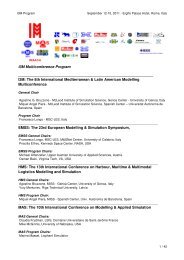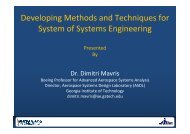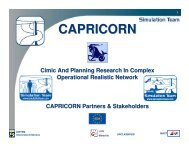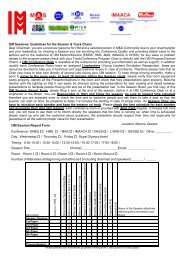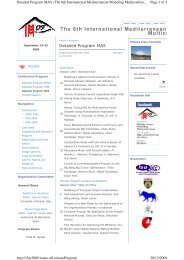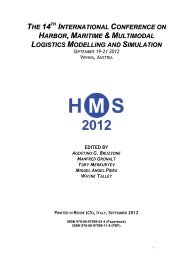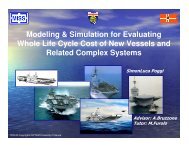HMS2006_F1 - Liophant Simulation
HMS2006_F1 - Liophant Simulation
HMS2006_F1 - Liophant Simulation
You also want an ePaper? Increase the reach of your titles
YUMPU automatically turns print PDFs into web optimized ePapers that Google loves.
Capacity Assessment Via <strong>Simulation</strong> for a Spanish Dry Port<br />
Álvaro García Sánchez 1 , Isabel García Gutiérrez 2 , Laura Pérez Juan 2<br />
1 Departamento de Ingeniería de Organización, Administración de Empresas y Estadística. Escuela Técnica<br />
Superior de Ingenieros Industriales. Universidad Politécnica de Madrid. José Abascal, 2. 28006. Madrid.<br />
alvaro.garcia@upm.es<br />
2 Área de Ingeniería de Organización. Departamento de Ingeniería Mecánica. Universidad Carlos III de Madrid.<br />
Avda. de la Universidad, 30. 28911 Leganés. Madrid. igarcia@ing.uc3m.es, lauraperezjuan@yahoo.es<br />
Abstract<br />
The transportation industry is ever more concerned with<br />
sustainable developement, and intermodal<br />
transportation offers great advantages in that sense.<br />
Among the different sorts of terminals, dry ports are of<br />
particular interest. Actually, dry ports are closely<br />
related to both inland terminals and to maritime ones,<br />
since they share their structure with the former and are<br />
connected to the latter performing as inland<br />
enlargements of the latter, facilitating freight<br />
transportation. This work focuses on the performance of<br />
a dry port located in Coslada. For the purpose of the<br />
study a simulation model was developed and several<br />
likely scenarios were assessed<br />
Key words: Intermodal, Combined Transport,<br />
<strong>Simulation</strong>, Terminal<br />
1. Introduction<br />
Intermodal transportation has demonstrated to<br />
be a rich field for the application of operations<br />
research and other techniques of quantitative<br />
analysis. A review of the processes which may<br />
be addressed, and the most suitable technique<br />
in each case, can be found in Gambardella and<br />
Rizzoli (2000). As they point out, among these<br />
techniques, simulation plays an important role<br />
providing an appropriate framework for<br />
decision-makers to assess solutions, sometimes<br />
provided by other techniques. Vis and Koster<br />
(2003) present a comprehensive review of<br />
applications devised to improve processes<br />
involved in intermodal terminals, categorized<br />
according to the purpose of the work, focusing<br />
on maritime terminals.<br />
This study belongs to a series of works within<br />
the framework of a research line devoted to the<br />
development of simulation based tools to assist<br />
the decision making processes in intermodal<br />
transportation. Actually, the work presented in<br />
this paper is the continuation of a previous one,<br />
where a model of the Spanish railway<br />
combined transport network was designed. The<br />
aim of this model was to assist decision making<br />
related to facilities and operation policies, and<br />
consisted of a pool of inland intermodal<br />
terminals (road-railway transshipment) and<br />
maritime terminals (ship-railway<br />
transshipment), and the railway network<br />
connecting them (Garcia and Gutiérrez, 2003).<br />
Since the main focus of this work was the<br />
global performance of the network, some<br />
assumptions were made when modelling<br />
terminals which may not be appropriate when<br />
conducting a more detailed study.<br />
Here, the authors undertake a more in-depth<br />
study of the modelling aspects of terminals, to<br />
build valid models for decision making at the<br />
terminal level. This work focuses on the<br />
performance assessment of a dry port under<br />
several scenarios, so that one may decide<br />
whether to acquire additional resources. To<br />
achieve that objective, a discrete event<br />
simulation model was developed and exploited.<br />
Although the model focuses on the<br />
particularities of a dry port (which is an inland<br />
terminal that works as an enlargement of<br />
maritime terminals), the designing guidelines<br />
might be transferred to other types of terminals.<br />
The paper is structured as follows. In section 2,<br />
a rough description of how dry ports work is
presented and, more specifically, how the dry<br />
port at study works.<br />
In section 3, the simulation model is described<br />
as well as the performance indicators/measures<br />
selected to assess the different scenarios.<br />
Following, in section 4, the experimentation<br />
conducted is summarised. Finally, section 5<br />
contains the main conclusions of the work.<br />
2. The dry port. Study objectives<br />
The relevance of dry ports is highlighted within<br />
an environment where intermodality is<br />
becoming an ever more public concern.<br />
Since the objective of a more sustainable<br />
development is closely related to transferring<br />
transport from the road to other means of<br />
transport, the interconnection of all available<br />
means is of paramount importance. But<br />
important though it may be, and despite<br />
governments and the Administration support,<br />
combined transport entails difficulties, such as<br />
coordination, which may account for its<br />
sluggish development.<br />
A dry port is a type of intermodal inland<br />
terminal, which is connected to one or more<br />
maritime terminals, with the capability of<br />
postponing customs control at the entry of its<br />
facilities. This feature speeds up freight<br />
delivery from ports towards their destination<br />
points.<br />
Spain has only recently included dry ports in its<br />
network and during the last few years several<br />
projects have been launched all over the<br />
country. Among them, the dry port in Coslada<br />
(Madrid), which has been working for some<br />
years now, is of high strategic value. Actually,<br />
railway combined transport has soared lately<br />
and in a country with the geographic<br />
characteristics of Spain, the maritime ports<br />
become key nodes for international freight<br />
exchange.<br />
The main reason to choose this dry port is the<br />
fact that it is a representative instance of this<br />
type of facilities.<br />
Besides, the dry port in Coslada (located on the<br />
outskirts of Madrid) has a strategic localization<br />
within the Spanish network (in the geographical<br />
centre of the Peninsula) and the high<br />
transportation needs of the region render this<br />
port a very appropriate and interesting case of<br />
study.<br />
Finally, the physical proximity and the<br />
forthcoming attitude of the managers of the dry<br />
port, willing to cooperate and facilitate the<br />
necessary data were additional factors<br />
supporting this election.<br />
The available resources involved in the<br />
operation of the terminal are the following<br />
ones:<br />
• A gantry crane, to load and unload<br />
trains, and reachstackers, mainly to<br />
move containers from the<br />
loading/unloading area to the storage<br />
area and vice versa.<br />
• A yard engine, which moves trains<br />
inside the terminal.<br />
• Tracks for reception and departure, and<br />
tracks for loading and unloading the<br />
trains.<br />
• Storage areas for containers and short<br />
term storage areas located by the<br />
loading and unloading rails.<br />
• Container consolidation/deconsolidation<br />
centre.<br />
With regard to the human resources, personnel<br />
working in the dry port belong either to a work<br />
team from RENFE (the Spanish railway<br />
company) or to a work team from the very<br />
terminal.<br />
For the purpose of the study only 20 and 40 feet<br />
containers were considered.<br />
First of all, although there exist units of<br />
transportation other than containters (such as<br />
swap bodies), most wares are stored in<br />
containers. And, secondly, although several<br />
sizes are available, most of them are either 20<br />
feet or 40 feet.<br />
RENFE owns the rolling stock in the dry port<br />
(the carrier wagons and the engines), and is also<br />
responsible for the management of these assets,<br />
which poses an additional constraint to the<br />
operation of the dry port, since some decisions<br />
are beyond the control of the managers in<br />
Coslada.
Figure 1. Areal sight of the dry port in Coslada<br />
The layout of the dry port is shown in the<br />
picture of Figure 1, an aerial sight, where the<br />
physical elements can be identified.<br />
With the only exception of customs control, all<br />
the operations in a dry port are exactly the same<br />
as those in an intermodal inland railway/road<br />
terminal. Following the pattern found in other<br />
similar models, such as in Kulick and Sawyer<br />
(2001) and Rizzoli et al. (2002), the basic<br />
operations modelled were the following:<br />
• Unloading containers arriving to the<br />
terminal in trucks to be transported by<br />
train and, the opposite process, loading<br />
containers in trucks for their final<br />
transportation by truck.<br />
• Loading outbound trains and unloading<br />
inbound trains.<br />
• Customs procedures, in case they have<br />
not been previously done in the<br />
maritime port of origin.<br />
• Container load manipulation in the<br />
consolidation centre, when required.<br />
• Trains arrival and departure.<br />
3. The simulation model features<br />
The objective was to assess whether the<br />
facilities and the current level of resources<br />
could meet the future demand within different<br />
scenarios.<br />
If not, some additional improvements of the<br />
level of resources should be analysed, so that<br />
the future demand could be met with acceptable<br />
levels of efficiency.<br />
The study was twofold, namely, analysing both<br />
the dry port’s effectiveness and efficiency in<br />
the different scenarios. In relation to the<br />
effectiveness, the main indicator was the total<br />
processing time for a container. The total<br />
throughput was of much less importance and<br />
therefore was not considered as a relevant<br />
indicator. However, to obtain a more detailed<br />
assessment of the system, the waiting time of<br />
containers in each operation can be valuable.<br />
With regard to the effectiveness, it was of great<br />
interest to identify potential bottlenecks and<br />
highly underexploited resources. Thus, the<br />
indicator chosen were: the use percentage of<br />
each resource (cranes and labour) and the<br />
average occupation of physical elements (such<br />
as rails and storage area).<br />
The complexity of the system and the stochastic<br />
nature of the processes involved in the dry port<br />
are the common features of those problems<br />
studied through simulation. Discrete event<br />
simulation allows the researcher to create an<br />
off-line model where experiments can be run<br />
instead of doing it in the actual system, and<br />
more importantly, at quite a lower cost.<br />
Among the range of simulation environments,<br />
Witness ® (by Lanner Group) was chosen to<br />
build the model with. Witness® has proved to<br />
be a suitable tool in studies of similar nature in<br />
the past and, actually, it was absolutely<br />
satisfactory for the current one.<br />
When defining the conceptual model, the<br />
authors decided to take a step ahead in<br />
comparison to the previously developed<br />
models. Among the enhancements, those most<br />
worth mentioning are:<br />
• Train length was flexible to some<br />
extent.<br />
• The loading/unloading operations<br />
performed by the gantry crane were<br />
represented in a more realistic way.<br />
Following, according to the information<br />
gathered from the dry port managers, the<br />
assumptions to obtain a valid model of the<br />
system are described.<br />
First, combined transport trains run according<br />
to settled schedules, thus arrival and departure<br />
times were established and available.
Storage<br />
areas<br />
Road transport<br />
area<br />
Recept./depart.<br />
tracks<br />
Gantry crane,<br />
reachstackers<br />
Tracks for<br />
loading/unloading<br />
Consolidation<br />
center<br />
Figure 2. Screenshot of the model’s display window<br />
In particular, on average a train is shipped<br />
everyday to every destination and a train arrives<br />
every day from every origin, but on Sundays,<br />
where trains neither arrive nor depart.<br />
Destination/origin points are the ports located<br />
in Valencia, Bilbao, Barcelona y Algeciras.<br />
As to the train length, the number of containers<br />
can not exceed a maximum number.<br />
However, if the train is due to leave and if the<br />
number of already loaded containers is greater<br />
than a lower bound, it is allowed to depart even<br />
if it does not contain its maximum load. If the<br />
minimum loading condition applies but first<br />
condition does not, the train is allowed to<br />
depart as soon as it does.<br />
Loading and unloading of containers onto the<br />
flat wagons are preferably carried on with the<br />
gantry crane, though if necessary reachstackers<br />
can be used as well.<br />
Loading operations are considered to be of a<br />
higher priority than unloading ones, in order to<br />
allocate resources when conflicts arise. The<br />
loading process is launched at around two hours<br />
in advance of the planned depart time and is<br />
finished twenty minutes before that time. From<br />
that moment on, no loading of the train is<br />
allowed.<br />
With regard to the containers coming from road<br />
transport, there is an unloading area where<br />
trucks park. Mobile cranes move to that area<br />
where trucks are unloaded. The container is<br />
carried either to the loading area (if its priority<br />
is urgent) or to the storage area (which occurs<br />
in most cases).<br />
Those trucks arriving to the dry port and whose<br />
destination point is Madrid are loaded with a<br />
mobile crane, in the unloading area.<br />
Those containers to be loaded to a truck (for<br />
regional delivery) can proceed from any of the<br />
following three sources: a recently unloaded<br />
container, the storage area or, finally, the<br />
consolidation/deconsolidation centre. In terms<br />
of the model, an attribute contained the value<br />
describing the origin of each container.<br />
Finally, the stochastic nature of the model is<br />
embedded, mainly, in the following elements.<br />
First, there is probability according to which<br />
containers are labelled as urgent; the number of<br />
containers that ought to undergo a<br />
redistribution process; and the failure rate of<br />
cranes involved in the loading/unloading<br />
operations.<br />
The image in figure 2 is a screenshot from the<br />
display of the model, where the most relevant<br />
components of the model can be identified.
Once the model had been programmed and<br />
carefully verified, a first set of experiments was<br />
conducted, where the model represented the<br />
current configuration of the system. More<br />
specifically, five replications were done, with a<br />
replication length of a week. The initial state of<br />
the model was obtained from de actual data of<br />
the system, provided by its managers.<br />
The results from these experiments were<br />
compared with the data gathered from the dry<br />
port managers and contrasted with them. The<br />
model proved to be a valid for the purpose of<br />
the study.<br />
5. Computational results<br />
Current situation<br />
According the analysis of the current situation,<br />
the main conclusions that can be drawn from<br />
the study are the following ones:<br />
− Those resources involved in moving freight<br />
are idle for roughly 40% of the time.<br />
− The system can handle a greater number of<br />
trains, but this is not occurring due to the<br />
number of scheduled trains.<br />
− The quality service is not too high, since the<br />
containers’ average time in the system is<br />
3.7 days. The explanation of such a high<br />
figure is, again, the number of scheduled<br />
trains and the fact that this dry port serves<br />
as temporary storage facility for the<br />
maritime ports it is connected to, since the<br />
lack of storage capacity in those ports.<br />
According to these results, a significant<br />
improvement in the dry port performance could<br />
be attained if the institution in charge of setting<br />
the number of trains and their schedules (which<br />
is RENFE) increased the allocation of this sort<br />
of resources to the system.<br />
Scenario 1<br />
Consistently with the growth expectancy for the<br />
following year, a future scenario was<br />
considered. This first scenario differed from the<br />
current situation in the demand, a 30% greater<br />
than the current one. This leap is reasonable,<br />
since the dry port started its operation in 2000<br />
and is still in its initial phase.<br />
As an assumption to this scenario, the number<br />
of trains was supposed to grow in the same<br />
amount as the demand.<br />
In this case, according to the simulation, the<br />
system was expected to perform as follows:<br />
− The resources involved in moving freight<br />
are busy at around 80% of the total time.<br />
− With that use percentage the dry port can<br />
perfectly meet the demand, no trains or<br />
trucks are unattended in this scenario,<br />
which means total effectiveness.<br />
− Besides, average waiting times decrease.<br />
For example the total time a container<br />
spends in the system till shipped is 3.3 days.<br />
This result is not surprising, since as the<br />
demand grows and the resources are not<br />
still overloaded, the greater number of<br />
trains yield that reduction.<br />
Scenario 2<br />
The last scenario under study was characterized<br />
by a demand level equal to its maximum<br />
estimated level: 140 trains per week (70 in and<br />
70 out), which represents almost a threefold<br />
increase of current level of resources.<br />
In case that demand grew to that extent it would<br />
no longer be realistic to keep the shift pattern as<br />
it currently is. For the sake of realism, in this<br />
second scenario the dry port is supposed to<br />
work round the clock in three different shifts.<br />
The expected performance of the system in this<br />
case can be summarized as follows:<br />
− The resources involved in moving freight<br />
are busy at around 90% of the total time.<br />
− Besides, waiting times decrease to an<br />
average of 2.5 days, which means a higher<br />
quality service.<br />
− On average, seven trains are unattended,<br />
which in relative terms represents a 10% of<br />
ineffectiveness. This result is not<br />
inconsistent with the level of idleness of the<br />
available resources, due to the fact that<br />
trains, though previously scheduled, might<br />
not arrive with a pattern which allows a<br />
balanced utilization of resources.
Usage percentage Current situation Scenario 1 Scenario 2<br />
Gantry crane 47% * 74% ±1% 87% ±2%<br />
Reachstacker 1 63% ±5% 84% ±4% 89% ±3%<br />
Reachstacker 2 63% ±6% 83% ±4% 89% ±3%<br />
Labour 1 66% ±5% 86% ±3% 87% ±6%<br />
Labour 2 59% ±6% 82% ±4% 85% ±2%<br />
Labour 3 47% 75% ±1% 85% ±2%<br />
Tracks 100% 100% 100%<br />
Table 1. Efficiency indicators<br />
Indicator Current situation Scenario 1 Scenario 2<br />
Avg. num. of 40-feet cont. in the storage area 529 ±11 602 ±12 629 ±33<br />
Avg, waiting time in the storage area (min.) 5610 ±30 5040 ±10 3600 ±66<br />
Unattended trains 0 0 7<br />
Avg time in the storage area (including urgent ones)<br />
(min.)<br />
5300 ±30 4800 ±10 3600 ±57<br />
Table 2. Effectiveness indicators<br />
As an overall conclusion with regard to the<br />
computational results, the dry port is expected<br />
to meet the demand both in the short and the<br />
medium term. Were there more containers<br />
available the system could offer a higher level<br />
of quality service, although this decision is<br />
beyond the dry port managers’ responsibility.<br />
Besides, in the current operating conditions and<br />
working on a 24 hour/day basis, if the demand<br />
reached its maximum potential value, there<br />
would be some shortage of resources and some<br />
trains would not be attended. In case the<br />
managers desired to overcome this<br />
ineffectiveness operating as the dry port does<br />
now, it would be necessary to acquire some<br />
additional assets, to the detriment of the<br />
efficiency (since a higher lever of idleness<br />
would be expected).<br />
6. Conclusions<br />
An example of a simulation study to carry on a<br />
quantitative analysis of the performance of a<br />
intermodal terminal of a particular nature (a dry<br />
port) has been presented. The same<br />
methodology applied to similar studies has<br />
been successfully used, introducing the<br />
appropriate modifications to represent the<br />
particularities of the system at study. Besides<br />
some improvements have been included, being<br />
the variability of the train length (between a<br />
lower and an upper bound) and the more<br />
accurate representation of the<br />
loading/unloading processes by means of using<br />
a gantry crane.<br />
The model, verified and validated, has allowed<br />
the prediction of its performance in two<br />
plausible scenarios, and asses this performance<br />
in terms of quality service and resource<br />
utilisation.<br />
Acknowledgements<br />
The authors would like to thank the dry port<br />
managers for their attention and their time,<br />
which provided with accurate and valuable<br />
data, facilitating the success of the study.<br />
References<br />
• Gambardella, L. M. y Rizzoli, A. E. (2000).<br />
The role of simulation and optimisation in<br />
intermodal container terminals. Proceedings<br />
of ESS2000 12 th European <strong>Simulation</strong><br />
Symposium and Exhibition, pp. 422-6.
• García, I. y Gutiérrez, G. (2003).<br />
<strong>Simulation</strong> model for strategic planning in<br />
rail freight transport systems. Institute of<br />
Transportation Engineers, Vol. 73, No. 9,<br />
pp. 32-40.<br />
• Kulick, B. C. y Sawyer, J. T. (2001). The<br />
use of simulation to calculate the labor<br />
requirements in an intermodal rail terminal.<br />
Proceedings of the 2001 Winter <strong>Simulation</strong><br />
Conference, pp. 1038-41.<br />
• Rizzoli, A. E., Fornara, N. y Gambardella,<br />
L. M. (2002). A simulation tool for<br />
combined rail/road transport in intermodal<br />
terminals. Mathematics and Computer<br />
<strong>Simulation</strong>, No. 59, pp. 57-71.<br />
• Vis, I.F.A. y Koster R. de (2003).<br />
Transshipment of containers at a container<br />
terminal: An overview. European Journal<br />
of Operational Research, Vol. 147, pp. 1-<br />
16.



